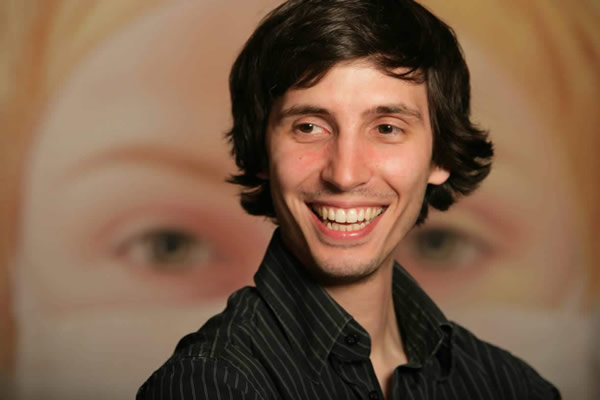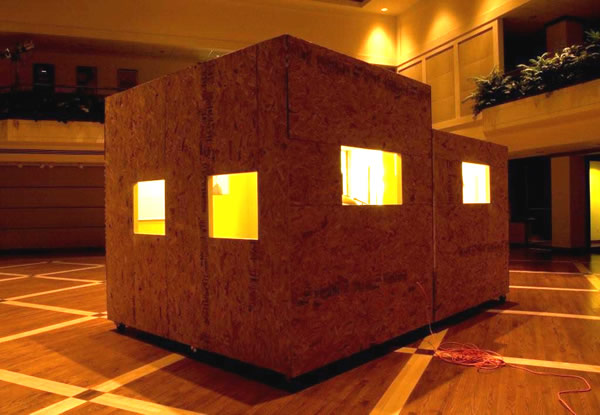A Conversation with Alfredo Barsuglia
 Andrea Schrammel (A), Director of the Austrian Cultural Forum Washington spoke with Alfredo Barsuglia (B), Fine Artists from Graz, Austria.
Andrea Schrammel (A), Director of the Austrian Cultural Forum Washington spoke with Alfredo Barsuglia (B), Fine Artists from Graz, Austria.
 Alfredo Barsuglia
Alfredo Barsuglia
A: I invited you to come to Washington to create an exhibition for the Atrium of the Austrian Embassy and I gave you certain conditions. I told you that you could hang your artworks and e.g. create a series for the Austrian Embassy, that you could do a performance, but that an art-installation could not be realized unless it could be put away when other events take place at the Atrium. You found your way around these conditions and as a consequence invented the Mobile Retreat Space. Could you just tell me about that? Is this your first Mobile Retreat Space, or have you already shown something similar to the Mobile Retreat Space? What is the idea behind it, what do you want to show us? I consider the Mobile Retreat Space to be an intervention in a semi-public space.
B: First, when I received the invitation to have an exhibition here I was thinking of putting something on the walls, a series of big drawings of beauty studio signs in New York, which I was working on at that time. Then you invited me to come here to see the space and I saw the walls, which were covered with grey fabric and partitioned through longitudinal wooden trims. I would have to deal with these walls, if I was to hang some artworks on them. I didn’t want to deal with them and decided to build my own walls, which would have to be moveable, as one of your conditions said. Out of this I got the idea to build my own house, within the big house, a space of my imagination, where I could nicely present my artworks, even more so because the exhibition would take place within the context of the Architecture Week DC. This is how the idea of the Mobile Retreat Space was conceived. The Mobile Retreat Space could be understood as a ‘Gesamtkunstwerk’ (synthesis of arts), it combines different media and gives the visitor a view of my little universe.
I always try to be aware of the space. Consequently, I develop and adjust my shows to the available space. I try to connect with the site, you could say: I work site-specific. It’s not as if you enter an exhibition space and are suddenly aware of the fact that you’re in an art-show. But you enter a room and then you start to discover and to read the objects and artworks and things you see and you start to understand the story and the content. The terms of reality and fiction mix up and sometimes reality blurs with fiction. The visitor doesn’t know which objects are ‘real’ and which ones are ‘fictive’… e.g the ‘ODERFLA Mouthwash’; you are unable to recognize whether it is real or invented. And that is exactly the question I am interested in. I like to leave the visitor in doubt of what is art(ificial) and what is real.
Furthermore, I like to give the visitor the possibility to become involved and discover my artwork by e.g. pressing a button of a telephone answering machine, opening a door into another room or reading a private diary.
 Mobile retreat at night. Photo: Barsuglia.
Mobile retreat at night. Photo: Barsuglia.
A: What about your beauty series? Can you tell us more about ODERFLA?
B: This is a long story! It all started almost 6 years ago, when I was working on the topic of teeth. The look and consistency of teeth is a criterion for beauty and implies the health and wealth of a person. They are a status symbol of our youth oriented society. Teeth are only a small part of our body that represent so much: health, wealth, age, social background and even nationalities. Among many other artworks I created a series of oral-hygiene products ranging from toothpaste to toothpaste squeezer. I called the series of products ODERFLA, which is my name Alfredo read backwards, and invented a new brand, which now includes beauty products, such as ‘ODERFLA Skin Cream’ or ‘Organic Beauty and Health Teas’, too. I was thinking of how to spread a brand, and started an inquiry into the importance of advertising.
A: What is the idea behind the Mobile Retreat Space?
B: I like to be with people but I also like being alone and I think that many people have a similar perception at events – they want to be there but at the same time they want to be surrounded by their own bubble where they feel safe, where they can behave the way they want to and don’t have to communicate with others if they don’t want to. The Mobile Retreat Space consists of three independent mobile cubes: a bathroom, a bedroom and a living room – each cube is open on one side. The cubes can be pushed together and create a closed cube system, a living unit, with no exit doors. So you have to enter the enclosed space before the cubes are pushed together.
At the opening reception there will hopefully be many people in the exhibition space and I’ll be there too, but all by myself, inside the Mobile Retreat Space and I won’t communicate with the visitors, I’ll relax and watch them from inside. I’m involved and I’m part of it but I’m still distant to a certain extent. I retreat instead of being part of the event, which is always some sort of an effort.
A: That is similar to the television project ‘Big Brother’ that everybody knows. ‘Big Brother’ deals with quite the same topic.
B: That’s right, the Mobile Retreat Space is an intimate space and not only can I observe the people outside, but they can watch me through the windows, too. So the Mobile Retreat Space is also about privacy and the public, about voyeurism and private life in both ways.
A: Can you tell us how mobile the construction is in the end?
B: On the one hand you can push the cubes together or apart and place them wherever you want within the exhibition space, the Atrium of the Austrian Embassy in Washington. The mobility of the Mobile Retreat Space allows other events like concerts to take place in the Atrium, where people need to be seated. On the other hand the Mobile Retreat Space cannot be taken out through the main door of the Embassy as a whole, because it is too big. This can be referred to the quote ‘One is only as free as far one knows his limits’. Additionally, the electric cord coming into the Mobile Retreat Space is like an umbilical cord from the bigger space, like a baby in its mother’s womb, supplying it with energy.
A: You mentioned to me that you think that architecture, as it influences the general feelings of all of us, is even more important to humanity than fine art.
B: Yes, for sure. Architecture is very important, because everybody has to live in and with some sort of architecture. We have to deal with architecture every day, but not with fine art.
A: Please speak about how contemporary fine art influences our lives?
B: The influence on our lives of contemporary fine art is not always obvious but long term it has a big impact on our daily life. Fine art is always a step ahead of society, it is always avant-garde.
E.g. think of gentrification: decades ago, nobody wanted do live in Soho, NY, but as soon as the artists moved there, other people followed and it became a very hip and expensive neighborhood. The same happens in Brooklyn nowadays. Another example is the movement of feminism in fine arts, which started in the early 60ies. Many female artists like Austrian VALIE EXPORT were ahead of their time. Her feministic actions in public spaces were very provocative and incomprehensible back in those days.
A: So, fine art addresses life situations and problems and maybe forecasts a different condition of life hereafter.
B: Exactly! But there is another economical aspect to the importance and impact of fine art. Just imagine how much the tourist industry profits from a country’s art scene. The arts – including architecture – are one of the most important and distinguishing features of a country. Indeed, people do visit a country for its cultural treasures and not for its car industry. And cultural institutions like museums, galleries and concert houses are retreat spaces as well!
